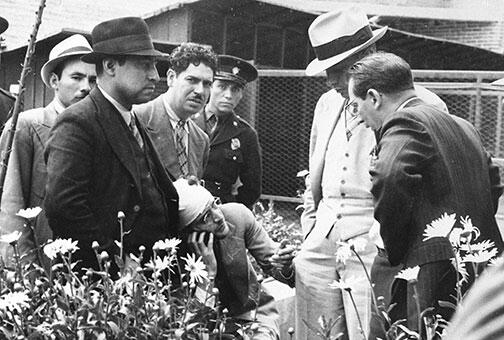History: A Murder in Mexico
Never-before-seen photographs shed light on Leon Trotsky’s murder
In August 1940, with much of the world’s attention trained on World War II raging in Europe, one of the most prominent figures in 20th-century Russian history was murdered in Mexico City. Leon Trotsky, a Marxist and a leader of the Bolsheviks who had been exiled by Joseph Stalin, was felled by an ice axe plunged into his skull by his secretary’s mysterious boyfriend.
Rubén Gallo, a professor of Spanish and Portuguese languages and cultures, has shed light on the story of Trotsky’s murder using never-before-seen photographs of Trotsky’s autopsy and other documents that were donated to Firestone Library in 2013.
Trotsky was murdered by Ramón Mercader del Rio, a Spaniard who was recruited for the deed by his mother and her lover, a Soviet operative. He wooed Trotsky’s secretary, an American woman, while she was vacationing in Paris and followed her back to Mexico City, then used her to gain admission to Trotsky’s office. Though historians knew the circumstances of the murder, the photos provide new details.
The perpetrator was caught moments after the murder, and the library’s collection includes photographs of him as he led the authorities through the crime scene to demonstrate what he had done. At one point, investigators handed him a copy of the murder weapon so he could show them how the grisly scene played out. One photograph shows the bloodstained floor of Trotsky’s office just after the killing; in another, Trotsky’s body is lying on a table as a doctor prepares to perform an autopsy.
Trotsky knew that Stalin was trying to murder him, Gallo says, and he took precautions. A photo in the collection shows the bricked-up windows of Trotsky’s house in Mexico City with uniformed guards stationed out front. Gallo’s essay about the documents was published in the Princeton University Library Chronicle in 2013.
Gallo, who directs Princeton’s Latin American studies program, says the photos and documents help illuminate a period in Latin America when the United States and the Soviet Union were struggling for dominance in the region. The Soviet embassy in Mexico City, for example, was at the time one of the primary centers of espionage in Latin America.
Gallo learned about the documents after publishing his 2010 book, Freud’s Mexico, which includes a chapter on Trotsky. Before her death in 1962, Trotsky’s widow gave the box to a filmmaker and, after the box changed hands again, Gallo facilitated its transfer to Firestone.













No responses yet